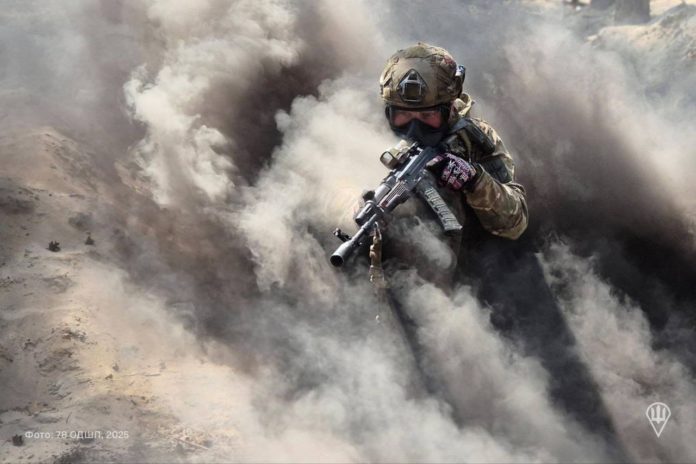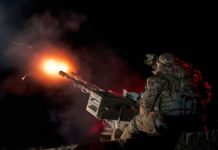As of May 1, 2025, Ukraine marks the 1163rd day of Russia’s full-scale military aggression. Over the past 24 hours, the situation remained tense along key frontlines in Donetsk and Kharkiv regions, as well as in the rear. Nearly 200 combat engagements were reported. Russian forces actively employed aviation, guided bombs, and kamikaze drones for massive strikes on Ukrainian positions and civilian infrastructure.
Ukrainian Defense Forces continue to repel enemy assaults effectively, inflicting heavy losses in manpower and equipment. At the same time, the Armed Forces of Ukraine (AFU) carry out precision strikes on enemy command posts, artillery systems, and ammunition depots.
Ukraine’s Defense & Military Developments
According to the General Staff of the Armed Forces of Ukraine, 196 combat engagements took place from April 30 to May 1, 2025. The most intense fighting occurred near Pokrovsk, Lyman, Toretsk, and Kupiansk. Russia launched 1 missile, conducted 92 airstrikes, and dropped 139 guided aerial bombs. Over 5,900 shelling incidents were recorded, including 145 MLRS attacks and 2,677 kamikaze drones deployed.
- Kharkiv axis: Two enemy assaults were repelled near Vovchansk.
- Kupiansk axis: Six Russian attacks near Petropavlivka, Hlushkivka, Novosynove, and Zahryzove.
- Lyman axis: 36 attempted breakthroughs near Novosergiivka, Tverdokhlibove, Novyi Myr, and others.
- Siversk axis: Two attacks repelled near Verkhnokamianske.
- Kramatorsk axis: Six assaults near Bila Hora, Andriivka, and Chasiv Yar.
- Toretsk axis: Ten enemy attacks in the areas of Druzhba, Dachne, Dyliivka, and Toretsk.
- Pokrovsk axis: 85 Russian assaults on over 20 settlements, including Stara Mykolaivka, Yelyzavetivka, and Myroliubivka.
- Novopavlivka axis: 16 attacks, especially near Pryvilne and Vilne Pole.
- Huliaipole axis: No engagements reported.
- Orikhiv axis: Five attacks near Stepove, Lobkove, and Kamianske.
- Dnipro River axis: One unsuccessful enemy attempt to breach defenses.
- Kursk region operations (Russia): 21 combat engagements, 13 airstrikes, 266 shellings, ongoing skirmishes.
The frontline remains highly dynamic. Russia continues to use airpower and drones to target both rear and forward positions, while suffering mounting losses due to Ukraine’s robust defense and counterattacks.
Russian Losses
As of the morning of May 1, 2025, according to the General Staff of Ukraine, Russia’s cumulative combat losses since the beginning of the full-scale invasion are as follows:
- Personnel — approximately 953,190 (+1,230 in the past 24 hours);
- Tanks — 10,732 (+3);
- Armored fighting vehicles — 22,364 (+11);
- Artillery systems — 27,136 (+45);
- MLRS — 1,375 (+1);
- Air defense systems — 1,148 (+2);
- Aircraft — 370;
- Helicopters — 335;
- UAVs (tactical level) — 34,401 (+112);
- Cruise missiles — 3,196;
- Warships/boats — 28;
- Submarines — 1;
- Vehicles and fuel tankers — 46,750 (+139);
- Special equipment — 3,869.
Between April 30 and May 1, Ukrainian forces inflicted substantial losses on Russian troops, especially in artillery and UAVs, underscoring effective air defense efforts and successful artillery operations by the AFU.
Ukrainian Strikes & Eliminated Targets
Ukraine’s Defense Forces continued executing precision strikes against Russian positions. Within the last 24 hours, they successfully:
- Hit 9 concentrations of enemy personnel, weapons, and military equipment;
- Destroyed 1 artillery system;
- Struck 1 air defense system;
- Eliminated 3 Russian command posts.
Effective counter-battery warfare and targeted command post strikes reflect increasing technological sophistication and coordination across Ukrainian artillery, drone reconnaissance, and missile units.
Diplomatic Initiatives & Negotiations
Between April 30 and May 1, 2025, a key diplomatic development was the signing of a major agreement between Ukraine and the United States on mineral resource access. The agreement sparked global debate and reactions from political leaders worldwide.
- US–Ukraine resource agreement signed: On April 30, Ukraine and the US formalized a deal granting the US prioritized access to Ukrainian mineral resources, including rare earth elements, titanium, uranium, lithium, graphite, and manganese. The agreement also includes the creation of a Joint Investment Fund for Ukraine’s recovery. Ukraine retains full control over extraction, and the agreement does not include any debt repayment for prior military aid.
- Global reactions: US Senator Marco Rubio welcomed the agreement as “a major step toward ending the war”; UK’s David Lammy called it “a historic milestone”; US Congressman Gregory Meeks criticized it as a “forced barter of resources”; Russia’s Dmitry Medvedev claimed Ukraine was “trading away national wealth.”
- Ukraine’s position: Foreign Minister Andriy Sybiha called the deal a milestone in strategic partnership. President Zelensky emphasized the need for increased pressure on Russia.
- Russian proposal for truce: Vladimir Putin proposed a unilateral ceasefire from May 8 to 10 to commemorate Victory Day. Ukraine dismissed it as insufficient.
- US role in negotiations: Secretary of State Marco Rubio urged both sides to offer tangible proposals and warned that the US might withdraw from the negotiation process if no progress is made.
This strategic agreement between Ukraine and the US solidifies bilateral ties and underscores the geopolitical stakes of the war. Mixed global responses and Russia’s symbolic truce offer reflect the heightened diplomatic tensions.
International Support for Ukraine
From April 30 to May 1, Ukraine received significant international backing, including arms packages, economic assistance, and new cooperation initiatives.
- First US arms sale under Trump presidency approved: The US State Department authorized over $50 million in defense exports to Ukraine, following the resource agreement.
- Belgium pledges €1 billion aid package: PM Bart De Wever announced a new bilateral support program, including F-16s — two in 2025 for parts and two more in 2026.
- EU considers doubling military aid to €40 billion: The EU diplomatic corps proposed doubling support in 2025, including 2 million ammunition units.
- Norway to invest €300 million in Ukrainian defense industry: Direct procurement from Ukraine’s defense manufacturers was approved.
- Germany sends new €1.4 billion package: During President Zelensky’s visit to Berlin, Chancellor Olaf Scholz unveiled new aid including air defenses, tanks, and drones.
These commitments affirm long-term Western engagement in strengthening Ukraine’s defense and rebuilding its economy. The scale of aid demonstrates deepening trust and recognition of Ukraine’s strategic role.
Humanitarian Situation in Ukraine
As of May 1, the humanitarian landscape remains critical. Russian attacks continue targeting civilian infrastructure, causing deaths, injuries, and widespread destruction.
- Donetsk region: On April 30, 3,272 shellings were recorded. In Dobropillia, a Geran-2 drone strike injured one civilian and damaged several buildings and vehicles. Mirnograd saw damage to 9 apartment buildings and 17 private homes. In Kostiantynivka, 25 homes were hit; Staroraiske and Korovyi Yar also suffered extensive damage.
- Sumy region: Shelling injured two male civilians aged 38 and 62 in the Mykolaivska community.
- Kherson region: On April 29, seven people were wounded by shelling in Kherson, Sadove, Stanislav, and Bilozirka, including two children.
- Kharkiv region: Nine civilians, including five children aged 5–15, were injured in Pivdenne following drone strikes.
- Odesa: Drone attacks on April 30 killed two people and damaged infrastructure.
- Parliamentary support: The Verkhovna Rada passed a law permitting the use of humanitarian aid transport for public passenger services.
- UN figures: Nearly 13 million people in Ukraine remain in need of humanitarian assistance — especially women, children, the elderly, and persons with disabilities.
Russia’s continued targeting of civilians escalates the humanitarian crisis. National authorities and international partners are stepping up efforts to support vulnerable populations.
Domestic Situation in Ukraine
Domestically, key developments involved mobilization efforts, defense industry reforms, budgetary measures, and healthcare support.
- Spring mobilization plan: The government approved the recruitment of up to 40,000 personnel by May’s end, focusing on drone operators and technical specialists.
- Digital military registry launch: The Ministry of Defense will roll out the “Obereg” e-registry, synchronized with the Diia app, to streamline conscription.
- Defense industry growth: In Kyiv, April data revealed over 4,000 drones were produced. President Zelensky called for a monthly 15% production increase.
- Economic performance: Ukraine’s GDP grew by 2.4% in Q1 2025, driven by IT, energy, and logistics sectors.
- Budget shifts: Parliament considers reallocating ₴110 billion from other programs to boost defense spending.
- Healthcare and rehabilitation: The Ministry of Health launched rehabilitation programs for wounded soldiers in 12 regions, with new centers in Odesa and Lviv.
Ukraine continues adapting its institutions to wartime realities — reinforcing defense capacity, supporting recovery, and maintaining economic and healthcare stability.
Conclusion
Day 1163 of the war illustrates Ukraine’s unwavering determination to resist aggression militarily, diplomatically, and internally. Despite continued mass attacks from Russia, the AFU hold firm, inflicting serious losses on enemy forces. With growing international support, critical bilateral agreements, mobilization reforms, and economic resilience, Ukraine forges ahead toward full sovereignty and victory.
🤝 SUPPORT US 💙💛
We continue to work only because you read and support us. If you appreciate what we do, please become our sponsor or donate here👇
☕️ buymeacoffee.com/meaninuak
or
☑️ patreon.com/MeanwhileinUkraine
Your support helps us continue delivering timely and accurate updates. Stay informed and stand with Ukraine! 🇺🇦
Together we are stronger! 🇺🇦
























